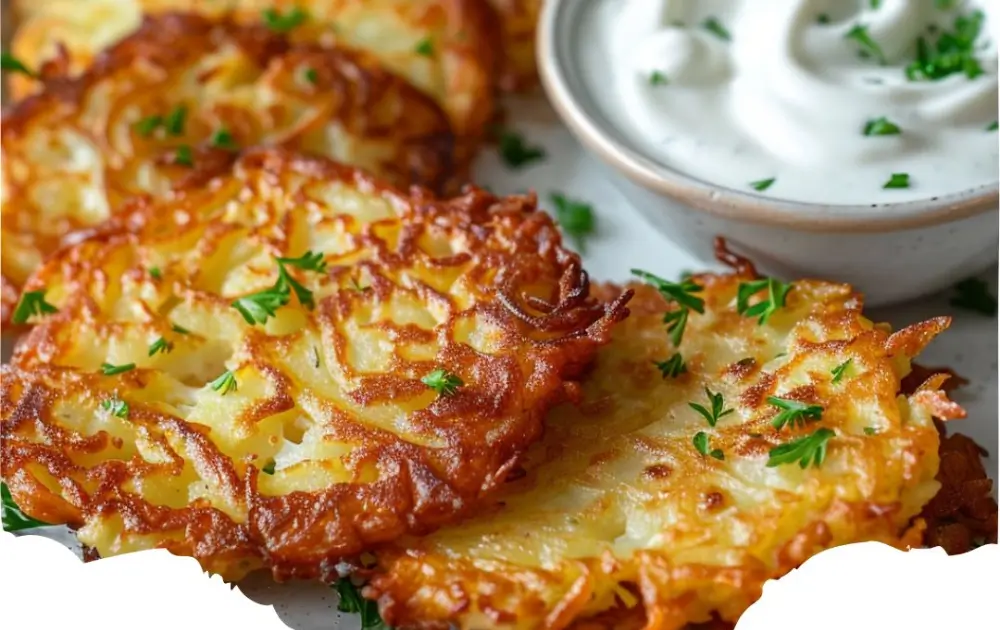Potato Latkes, a cherished dish in Jewish cuisine, embody the essence of simplicity and tradition. These crispy, golden pancakes made from grated potatoes and onions are a staple during Hanukkah, but their delightful taste and texture have made them a beloved treat year-round. The art of making latkes involves combining a few basic ingredients to create a dish that’s rich in history and flavor.
Print
Potato Latkes
- Total Time: 40 minutes
- Yield: Serves 6-8 1x
- Diet: Gluten Free
Description
Potato Latkes are a classic dish, traditionally served during Hanukkah but beloved year-round. These crispy potato pancakes are made from grated potatoes and onions, fried to golden perfection. They’re a simple yet delicious treat that can be enjoyed with a variety of toppings.
Ingredients
1 lb 2 large russet potatoes, peeled
1/4 cup all-purpose flour
1/2 medium onion, peeled
1 tsp baking powder
1 tsp fine sea salt
1/4 tsp freshly ground black pepper
1 large egg
Kosher salt, to sprinkle
Vegetable oil or extra light olive oil for frying
Instructions
Grate the potatoes and onions on the large holes of a box grater or on the grating disk of a food processor. Transfer the mixture to a cheesecloth or a clean, lint-free dishtowel and squeeze out as much of the liquid as possible. You’ll be surprised how much liquid comes out.
In a large mixing bowl, whisk together flour, baking powder, salt, and pepper then whisk in the egg. Add in the squeezed dry potatoes and stir until the potatoes are evenly coated in the batter.
Heat a large, heavy-bottomed skillet over medium-high heat and add about 1/4” of oil (enough to generously coat the bottom of the pan). Once the oil shimmers, add the batter to the pan 1 heaping tablespoon at a time (or use a trigger-release ice cream scoop) and immediately press with a spatula to form disks. Fry until the edges are browned, 4-5 minutes. Flip and cook until the second side is golden brown, about 3 to 4 minutes more.
Transfer latkes to a paper-towel-lined plate and immediately sprinkle lightly with kosher salt.
Repeat with the remaining potato mixture adding more oil to the skillet as needed. Serve warm latke with sour cream garnished with chives.
Notes
- Keeping the grated potato mixture in cold water can prevent it from browning, but make sure to drain and squeeze dry thoroughly.
- For gluten-free latkes, substitute all-purpose flour with a gluten-free flour blend.
- Ensure the oil is hot enough before frying to get crispy latkes without absorbing too much oil.
- Prep Time: 20 minutes
- Cook Time: 20 minutes
- Category: Side Dish/Appetizer
- Method: Frying
- Cuisine: Jewish
Nutrition
- Calories: Approximately 250 per serving (varies with frying oil)
- Sugar: 2g
- Sodium: 400mg
- Fat: 14g (varies depending on amount of oil absorbed)
- Carbohydrates: 28g
- Fiber: 2g
- Protein: 4g
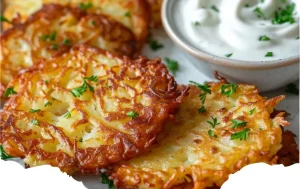
FAQs About Potato Latkes
Can I make latkes gluten-free? Yes, you can make latkes gluten-free by substituting traditional flour with a gluten-free flour blend or using almond meal as a binder in your mixture.
How can I prevent my latkes from falling apart while frying? To prevent latkes from falling apart, ensure the mixture is not too wet by squeezing out excess moisture from the grated potatoes and onions. Additionally, pressing the latke mixture firmly into patties before frying helps them hold together.
What’s the best way to reheat latkes? The best way to reheat latkes is in the oven. Spread them out on a baking sheet and bake at 350°F until they’re hot and crispy again, about 5-10 minutes.
Can latkes be frozen? Yes, latkes can be frozen. Cool them completely on a wire rack, then lay them flat on a baking sheet to freeze individually. Once frozen, transfer them to a freezer-safe bag or container. Reheat directly from frozen in the oven for best results.
Are there any tricks to making extra crispy latkes? For extra crispy latkes, make sure your oil is hot enough (about 375°F) before adding your latkes. Don’t overcrowd the pan, as this can lower the oil’s temperature. Using starchier potatoes like Russets and thoroughly draining any liquid from the mixture also contributes to a crispier outcome.
Selecting the Right Potatoes
Choosing the right type of potato is crucial for achieving the perfect latke. Starchy potatoes like Russets are ideal because they help create a crispy exterior while maintaining a tender interior. The starch acts as a natural binder, reducing the need for excessive flour or matzo meal and preserving the authentic potato flavor.
Preparing the Potato Mixture
The first step in making latkes is to grate the potatoes and onions. Using a box grater or food processor achieves the desired texture, but it’s important to squeeze out as much liquid as possible from the grated mixture. This ensures that the latkes will be crispy once fried. After draining, mix the potatoes and onions with eggs, a small amount of flour or matzo meal, salt, and pepper to form the batter.
Mastering the Frying Technique
Frying latkes to perfection is an art. Heat a generous amount of oil in a frying pan over medium-high heat – enough oil to come up about a quarter-inch on the sides of the latkes. The oil needs to be hot enough so that the latkes sizzle upon contact, but not so hot that they burn before cooking through. Form small patties from the mixture, place them in the oil, and flatten them slightly with a spatula. Fry until the edges are deeply golden and crispy, then flip and cook the other side.
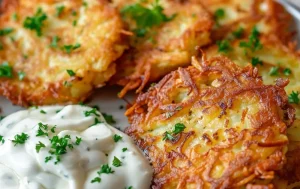
Serving Suggestions
Potato Latkes are traditionally served with applesauce and sour cream on the side. The combination of the latkes’ crispiness with the smoothness of the sour cream and the sweetness of the applesauce creates a harmonious blend of flavors. Some prefer to experiment with modern toppings like smoked salmon, caviar, or even cheese, making latkes a versatile dish that can be adapted to various tastes.
Enjoying Latkes Beyond Hanukkah
While latkes hold a special place in Hanukkah celebrations, symbolizing the miracle of the oil, their appeal extends far beyond the holiday season. They can be enjoyed as a side dish, appetizer, or a savory snack. Hosting a latke-making party is a fun way to bring friends and family together, sharing the joy of cooking and the pleasure of eating this simple, yet delicious, dish.
Innovating with Latke Variations
Beyond the classic potato latke, culinary creativity has led to a variety of innovative takes on this traditional dish. Adding vegetables like zucchini, sweet potatoes, or carrots to the mix can introduce new flavors and colors, making each bite a delightful surprise. Experimenting with additions like fresh herbs, cheese, or even a pinch of spice can transform the humble latke into a gourmet experience, showcasing the versatility of this beloved pancake.
The Secret to Extra Crispy Latkes
For those in pursuit of the crispiest latkes, a few key techniques can make all the difference. Ensuring the grated potato mixture is as dry as possible is crucial; the less moisture, the crispier the latke. Another tip is to press the latke patties firmly between towels before frying to remove any remaining liquid. Some cooks swear by adding a tablespoon of cornstarch to the batter, which can help achieve that coveted crispy exterior.
Latkes as a Canvas for Cultural Fusion
Potato latkes have become a canvas for cultural fusion, marrying traditional Jewish cooking with flavors from around the world. Incorporating ingredients like kimchi, curry spices, or even using panko breadcrumbs for coating introduces a global twist to the dish, reflecting the diversity of modern culinary practices and tastes.
Hosting a Latke Bar
A latke bar is a festive way to entertain, allowing guests to customize their latkes with a variety of toppings. Set up a station with hot latkes and bowls of different accompaniments: traditional applesauce and sour cream, as well as less conventional options like guacamole, tzatziki, or spicy aioli. This interactive dining experience not only makes for a memorable event but also celebrates the latke’s adaptability and universal appeal.
Latkes in Contemporary Culinary Scenes
Potato latkes have found their place in contemporary culinary scenes, appearing in upscale restaurants and casual dining spots alike. Chefs appreciate them for their simplicity and potential for innovation, often presenting latkes as part of sophisticated dishes or reimagined street food. This enduring popularity underscores the latke’s role not just as a holiday staple but as a cherished part of global cuisine, enjoyed by people of all backgrounds and culinary preferences.
Elevating Latkes for Special Occasions
Latkes can be elevated to a dish worthy of special occasions with a few gourmet touches. Serving them as a base for luxurious toppings like smoked salmon and caviar or a dollop of crème fraîche transforms the humble latke into an elegant appetizer. This approach to serving latkes not only enhances their flavor profile but also showcases their potential as a sophisticated dish for celebrations and gatherings.
Pairing Latkes with the Perfect Beverage
Finding the perfect beverage pairing can elevate the latke eating experience. A crisp, dry white wine or a light-bodied beer complements the latkes’ richness and crispiness, cleansing the palate between bites. For non-alcoholic options, sparkling water with a twist of lemon or a tart apple cider offers a refreshing contrast to the savory flavors of the latkes.
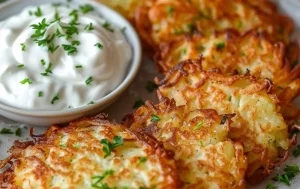
Latkes as a Learning Tool in the Kitchen
Cooking latkes can serve as an excellent learning tool for novice chefs and young cooks. The process teaches fundamental cooking skills such as grating, mixing, seasoning, and frying. Additionally, experimenting with latke variations encourages creativity and culinary exploration, making it a fun and educational experience in the kitchen.
Sustainability in Latke Preparation
Incorporating sustainability into latke preparation can involve using locally sourced potatoes and onions, choosing organic ingredients, and minimizing waste by utilizing leftover vegetables. These practices not only enhance the flavor of the latkes but also contribute to a more environmentally friendly cooking process, aligning with modern culinary values.
Latkes and Community Traditions
Latkes play a significant role in community traditions, serving as a dish that brings people together during Hanukkah and beyond. Organizing latke cook-offs, community potlucks, or charity events centered around making and sharing latkes fosters a sense of togetherness and celebration. Through these communal activities, the tradition of making and enjoying latkes is passed down through generations, preserving its cultural significance while allowing for new interpretations and memories to be created.
Exploring Healthier Alternatives for Latkes
In response to the growing interest in healthier eating, exploring alternatives for making latkes can cater to various dietary needs without compromising taste. Using olive oil or avocado oil for frying offers a heart-healthy fat option, while substituting traditional white potatoes with sweet potatoes or zucchini provides additional nutrients and fiber. Baking latkes in the oven instead of frying them reduces oil content, producing a lighter version of this beloved dish.
The Art of Perfect Latke Presentation
Presentation plays a crucial role in transforming latkes from a simple dish to an eye-catching culinary creation. Arranging latkes on a platter with garnishes like fresh dill, parsley, or a sprinkle of sea salt not only adds to their visual appeal but also enhances their flavor. Serving them on individual plates with artistically applied toppings can turn each latke into a mini masterpiece, elevating the overall dining experience.
Latkes Across Cultures
While traditionally associated with Jewish cuisine, the concept of latkes resonates across cultures under different names and variations. Exploring these global interpretations, such as Korean jeon or Swiss rösti, highlights the universal appeal of grated vegetable pancakes. Integrating flavors and techniques from these international dishes into latke recipes enriches the culinary landscape, showcasing the versatility and adaptability of this simple yet beloved food.
Seasonal Twists on Traditional Potato Latkes
Seasonal ingredients offer an opportunity to infuse traditional latkes with fresh, dynamic flavors. Incorporating pumpkin or squash in the fall, fresh herbs in the spring, or corn and zucchini in the summer can tailor the dish to seasonal tastes and availability. These variations not only celebrate the bounty of each season but also introduce a delightful twist to the classic latke recipe.
Sharing the Joy of Latkes Through Social Media
In today’s digital age, sharing the joy of cooking and eating latkes through social media platforms can inspire others to discover and embrace this dish. Posting photos, recipes, and videos of latke-making adventures encourages a virtual community of food enthusiasts to experiment with their own versions. Social media serves as a bridge connecting diverse culinary traditions, making the world of latkes accessible to a global audience eager to learn and taste.
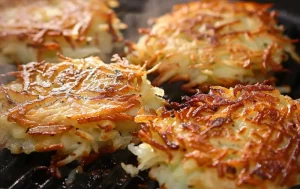
Conclusion
Potato Latkes are a versatile and beloved dish that can be enjoyed in many ways, whether following traditional recipes or exploring new, innovative variations. From the selection of ingredients to the final presentation, making latkes is a culinary adventure that celebrates cultural traditions while inviting personal creativity. By incorporating tips for achieving the perfect texture, experimenting with healthier alternatives, and embracing the dish’s cross-cultural potential, cooks of all levels can enjoy the rich flavors and satisfying crunch of latkes. Share your latke creations with family, friends, or the online community to spread the joy and warmth that this classic dish brings to tables around the world.

